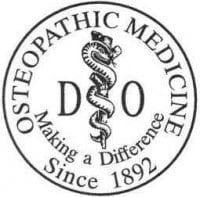
Osteopathic medicine provides all of the benefits of modern medicine including prescription drugs, surgery, and the use of technology to diagnose disease and evaluate injuries. It also offers the added benefit of hands-on diagnosis and treatment through a system of therapy known as osteopathic manipulative medicine. Osteopathic medicine emphasizes helping each person achieve a high level of wellness by focusing on health promotion and disease prevention.
What does this mean?
A challenge in any one part of the body can affect all other parts of the body and cause patterns of symptoms. This is why Osteopathy doesn’t just treat a problem locally. It looks at the body as a whole to find and treat the cause of a problem, often leading to lasting relief from recurring problems. Osteopathy seeks to identify the underlying cause of your current challenges. An Osteopathic Practitioner has been trained for several years to deeply understand how all of your bodily systems (circulation, skeleton, muscles, ligaments, lymphatic fluid, ect) work TOGETHER and impact each other.
Your body is a complex machine with many parts and systems that interact and affect each other’s functioning in a reciprocal fashion. Osteopathic Practitioners are trained to assess your body in a comprehensive way, choosing from among a vast array of techniques to treat the challenge, and often resolve it more fully than conventional medicine.
Osteopaths are qualified to use a great variety of manual and physical techniques to evaluate musculo-skeletal conditions and acute and chronic problems. They can also do physical exams with a focus on the body as a whole. Osteopathic Practitioners rely a lot on their unique form of manual therapy. They are considered around the world to be a gentler, more natural and effective alternative.
Here are some conditions that our Clinic focuses on in general:
- Cranial Dysfunctions, such as Concussions, Sinusitis, Vertigo, Tinnitus, TMJ, pain following dental procedures, recurring headaches, etc.
- Osteopathy is also effective in treating common physical pain conditions such as: back pain, neck pain, and joint problems including hips, knees, ankles, feet, shoulders, elbows, and wrist.
Acute and Chronic problems- food sensitivities, digestive issues, high blood pressure, high cholesterol, low functioning thyroid, coughs and colds
- Women’s Health – migraines, hormonal imbalances, Pre-menstrual syndrome, somato-emotional symptoms such as anxiety or insomnia
- It is also beneficial for a wide variety of other health issues such as digestive and body imbalances, headaches, circulatory problems, cramps, chronic fatigue, inability to relax, fibromyalgia and rheumatic problems.
What can I expect during an Osteopathic Consultation & Treatment?
The goal of Osteopathic treatment is to find the cause of your pain or challenges, recognize them and alleviate them.
In order for the Osteopath to accomplish this, you will be asked to complete a health history questionnaire to share your medical history and some details about your challenges. The Osteopath will review this with you and a more detailed history of your current complaint and symptoms will also be discussed.
She will then assess you using various osteopathic assessment techniques to gain a clearer picture of the cause of your symptoms. She will verify all of the tissues and structures surrounding the problem area, as well as assess you overall to determine how your current complaint might be impacting over structures of the body, or vice versa. She will explain to you what she finds, and how it all “fits together”.
The initial visit includes at least a brief physical exam and Osteopathic manipulation using various osteopathic techniques. Osteopathic manipulation treatments are generally gentler and have a deeper effect on the body. The choice of techniques are usually determined by your needs that particular day, as well as what we are trying to accomplish overall in your body. Any potential contra-indications are taken into consideration. The need for follow-up visits will be discussed.
Initial Osteopathic consultations and treatments usually take approx. 1 hour, and follow up sessions are 30 minutes in duration. The duration and frequency of treatments depends on the acute or chronicity of the condition. Ideally it is great to visit once every 4-8 weeks for maintenance follow ups.